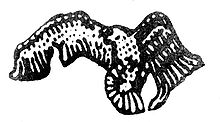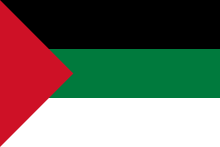Pan-Arabism
Pan-Arabism is a special form of Arab nationalism that the Arab cultural nation , in the sense of a common language and culture , that is, all Arabs from the Atlantic to the Persian Gulf, wants to unite in a common nation-state instead of the many Arab states today. Pan-Arabism is one of the anti-colonialist part of the pan movements . It is mostly based on the Arabic language . Pan-Arabism thus competes with the concepts of Pan-Islamism , Pan-Semitism and Pan-Africanism - but also with regionalist and other nationalist concepts, such as B. Pan-Syrism or Greater Syria ideology.
Pan-Arabism sees the split in Arab unity as a result of colonization by various occupiers.
history
In the 19th century, Arab nationalism developed in response to Ottoman imperialism . The European ideas on the emerging concept of the “nation” played a major role: the Arabs developed an awareness of a national and political identity. Finally, the concept of a comprehensive Arab nation-state was called "Pan-Arabism", which was an alternative to " Ottomanism ". “Ottomanism” endeavored to preserve the multi-ethnic state of the Ottoman Empire .
Since European imperialism, which encroached upon the former Ottoman territories through Great Britain and France after the end of the First World War , prevented the Arab nation state, the nationalisms of the individual Arab nation states developed , with the exception of Egypt, which had already developed a genuinely Egyptian nationalism . The pan-Arab thought moved more and more into the background, formed an abstract goal.
Even when the individual Arab states developed their own nationalisms, European ideologies again played important roles, e. B. in Arab socialism . This particular variant of Arab nationalism led to some attempted amalgamations of Arab states. a. on the United Arab Republic , consisting of Egypt and Syria: After taking power in 1954, Gamal Abdel Nasser became an ardent advocate of Arab nationalism in the sense of Nasserism . The Arab nationalists movement was also oriented towards him . The short-term attempt at unification by the two Arab states failed with the termination of the union by regionalist circles in Syria, which did not want to accept the Egyptian hegemony.
In response to the founding of the United Arab Republic, the Iraqi King Faisal II and his Jordanian cousin Hussein I founded the Arab Federation in February 1958 , which only existed for six months. Another representative of the pan-Arab idea was Libya's revolutionary leader Muammar al-Gaddafi , who saw himself as a student of Nasser and a. for the Federation of Arab Republics , but also proposed numerous other unification projects.
The Arab national idea had already arisen during the last years of the Ottoman Empire. Islamic reformers under Ottoman rule translated the French "patrie" with the term " Watan ". The vision of the Islamic umma preferred by the Sultan and his empire was replaced by the idea of an Arab "nation" detached from religion. The Syrian Michel Aflaq , who comes from a Christian-Orthodox family , was a pioneer of Baathism as a pan-Arab thought and political direction and co-founder of the Baath Party , plays an important role.
The ideology of pan-Arabism created the Arab-Islamic identity. Pan-Arab thinkers gave this newly formed national identity a meaning that cannot be separated from Islam, which Aflaq also confirmed.
After the Six Day War in 1967, Arab nationalism fell more and more into a crisis and lost popularity in relation to Islamic fundamentalism . With the increasing power of the Nasserists and later the Baathists, Arab nationalism developed into an instrument of oppression against the national minorities in the Arab countries.
Pan-Arabism has largely been considered a failure since around the early 1990s. Libya was the last state to represent him under Gaddafi.
Pan-Arabic colors
Like Pan-Africanism and Pan-Slavism , Pan-Arabism has its own colors: black, red, white and green.
See also
literature
- Sven Speer: Pan-Arabism - a failed transnational idea? In: Rüdiger Robert, Daniela Schlicht, Shazia Saleem (eds.): Collective Identities in the Near and Middle East. Studies on the relationship between state and religion. Waxmann, Münster et al. 2010, ISBN 978-3-8309-2394-7 , pp. 75-93.
- Bassam Tibi : From the kingdom of God to the nation state. Islam and Pan-Arab Nationalism . Suhrkamp, Frankfurt am Main 1987, ISBN 3-518-28250-6 (= Suhrkamp-Taschenbuch Wissenschaft , Volume 650, also a dissertation at the University of Frankfurt am Main 1971).
Individual evidence
- ↑ Tilman Lüdke: Pan ideologies. Chapter: The History of Pan-Ideologies. In: European History Online. August 30, 2012, accessed October 10, 2014 .
- ↑ a b Christian Szyska: pan-Arabism. Federal Agency for Civic Education, accessed on October 10, 2014 .
- ^ Alfred Schlicht: History of the Arab World , Reclam, Stuttgart 2013, p. 11
- ^ Alfred Schlicht: History of the Arab World , Reclam, Stuttgart 2013, p. 11 f.
- ↑ Alfred Schlicht: History of the Arab World , Reclam, Stuttgart 2013, p. 12
- ↑ a b Gereon Breuer: Pan-Arabism instead of exporting democracy! The US is considering exporting democracy to Syria. One day pan-Arabism was supposed to push back Islamism and unite the divided Arab world. In: Blue Narcissus. September 9, 2013, archived from the original on October 16, 2013 ; accessed on October 11, 2014 .


